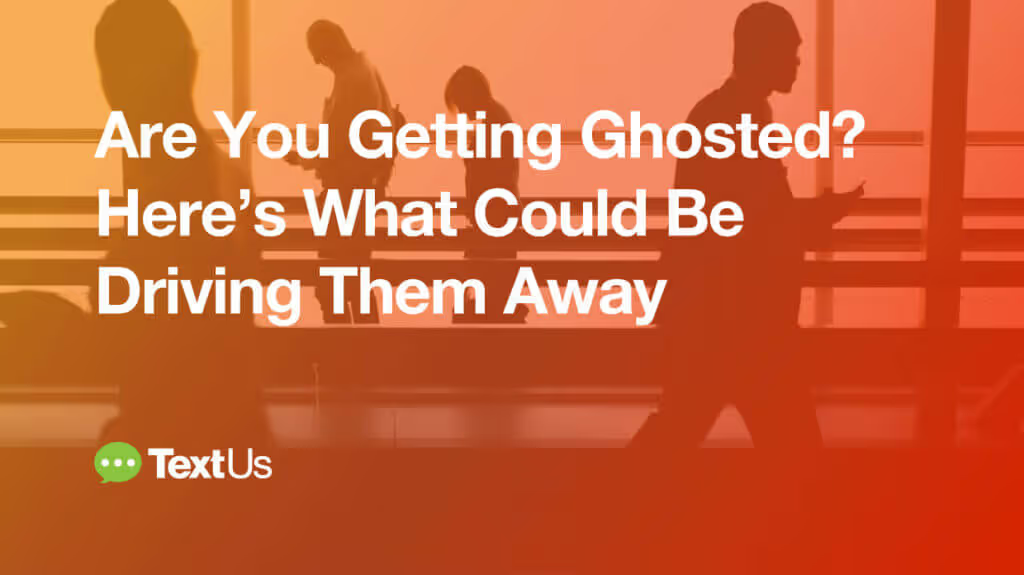Are You Getting Ghosted? Here’s How Your Texts and Emails Could Be Driving Them Away
Text and emails are wonderful for speed and clarity, but trickier for figuring out what went wrong when a customer ghosts you. Here are some tips.
Published
May 16, 2019

We’ve all been there. You’ve had a great back and forth with an excited customer, and then suddenly — nothing. It’s like your emails and texts are going into a black void. And you can’t figure out what happened.It’s not like the old days when you had in-person meetings where you could judge body language and facial expressions to plot your next move. Text and emails are wonderful for speed and clarity, but trickier for figuring out what went wrong when a customer ghosts you.Here’s what might be happening.
You’re getting chummy too quickly
You want to text because it’s quick and informal, but like any new relationship, if you get informal too fast, you’ll drive people away.Think friendly, not clingy. This can be a delicate balance. You don’t want to seem too business-formal, but you also don’t want to come off like you’re that stereotypical slimy salesman who talks a little too close to you.
Don’t: get too familiar
“Hey hey, Jenn, it’s Josh!!! What’s going on, friend? Can I catch you on the phone today?”
- Don’t use a nickname unless the person has introduced themselves with that name.
- Don’t use pet names — even something as simple as “friend” comes off as over-familiar.
Instead: be friendly, but respectful
“Hi Jennifer, it’s Josh from TextUs. Checking in — it was great to meet you at last week’s conference. I’d love to set up a call — how’s tomorrow at 3 pm?”
- Introduce yourself and reference where you met.
- Be specific about the next steps.
You’re relying too heavily on email
Email is fantastic for longer follow-ups, like summarizing a meeting or phone call. But you don’t need email for quick check-ins and meeting scheduling anymore. If you’re using email for these brief communications, those emails will get lost in the inbox shuffle and your customers will start to ignore you.
Don’t: always send an email</h3“Hello, Jennifer,
I’m sending you this email to see where you are in the decision process, and if you’d like to set up a phone call. I’d love to walk you through our newest features -—I think it would really help your next steps. Here’s a list of times I have available. Let me know what works for you.”
- Don’t spend four sentences on what could be one. Your customer has already clicked out by the second line.
- Don’t manually list dates and times for meetings — use an automated calendar like Calend.ly so your customer can click right now and set their meeting.
Instead: text strategically
“Hey, Jennifer, I’d love to set up a quick call tomorrow to walk you through our new features. Here’s a link to my calendar: calendly.com/example”
- Send a text if you can get your point across in a sentence or two.
- Be concise and to the point and include a clear call to action.
You’re not there when they’re ready
Your customers are used to getting what they need, right when they need it. They click a button and get their groceries delivered. They hit a chatbot and their internet is fixed right away. You might be quick to reply to an email, but what happens when you’re at lunch or in a meeting? This is when real-time communication will be a lifesaver.
Don’t: leave them hanging
Your customer emails: I have a question about one of your new features. Can you give me a call?You: are silent because you’re stuck in a long lunch meeting and can’t send an email.
Instead: tell them when you’re available
Your customer emails: I have a question about one of your new features. Can you give me a call?You: text them back right away, letting them know you’ll call them in an hour, but they can also shoot questions over text right now.
You aren’t listening
Is it possible that your customers are responding, but you aren’t hearing what they’re saying? Keeping customers engaged often means reading between the lines and adjusting your approach when you sense resistance or reluctance.Take a careful inventory of your texts and emails. Are you sending too many texts and emails, even though you’re sensing a “back off” signal? Are you clearly and accurately answering customer questions?Don’t:
- Get stuck in a routine. There is no one-size-fits-all email and text strategy. Every customer responds to different approaches.
- Send texts and emails without carefully reading through your previous communication. Make sure you’ve addressed every issue.
- Lose sight of the process while aiming for the goal. You want the sale but be sensitive to your customers’ timelines and needs.
Instead:
- Inventory your texts and emails each quarter. Are you responding clearly and addressing each question? Are you shooting off replies out of habit instead of reading what each customer is saying?
- Deepen your empathy. Emotional intelligence makes great sales because you’re closely attuned to your customers’ changing needs. Are you picking up on tone changes in emails and texts?
Continue Reading
Frequently Asked Questions
Business Texting
Built for Results
Create and convert pipeline at scale through industry leading SMS software




